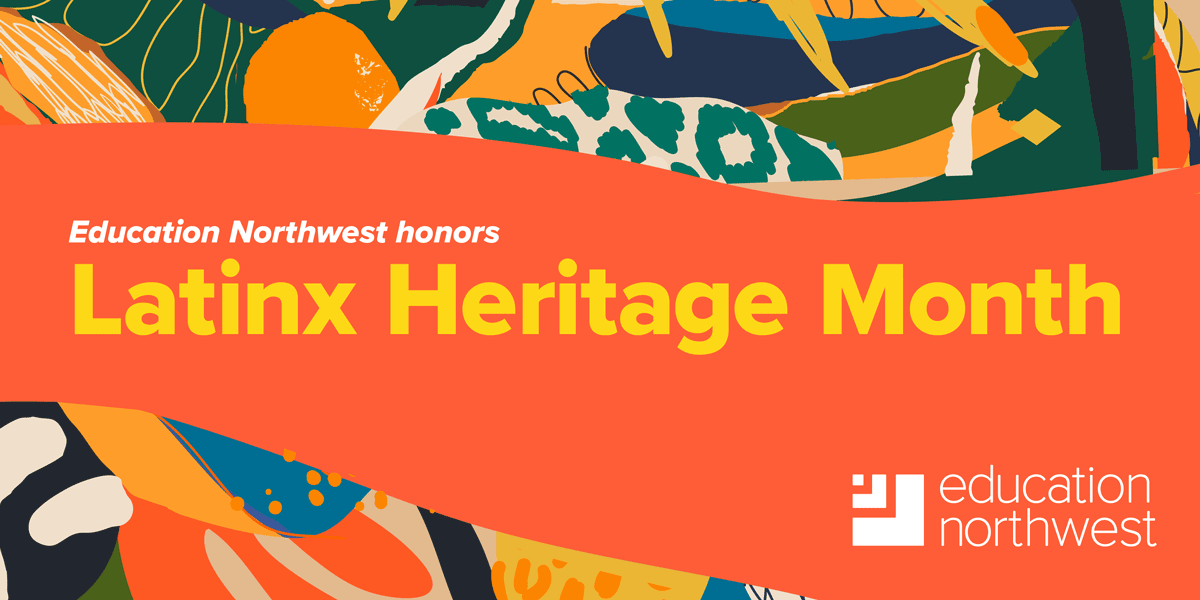Latine Educators Tell Their Stories

As we observe Hispanic Heritage Month, we are deeply inspired by the five Latine educators who are sharing their stories with us in 2019.
This year, we profile a kindergarten teacher serving as a role model, a middle school teacher inspiring her students the same way a teacher inspired her and three colleagues from Roosevelt High School who are building a welcoming school community for students of color. All five educators express in their own words the need for schools to recruit and develop more teachers of color.
Filling an Important Role
Mariano Lizano Alpizar, Sherwood Forest Elementary, Bellevue School District, Washington
When Mariano Lizano Alpizar was in high school in Paraguay in the 1990s, he took inspiration from a male teacher who emphasized that learning history was a way to make the future better. “He inspired me to become a teacher who could impact the lives of my students with knowledge, understanding, and service,” Mariano says.
As a male Latino teacher in a kindergarten classroom, Mariano fills an important role. Nationally, male Latino teachers make up less than 2 percent of the K-12 education workforce and are even more scarce in the early elementary grades.
“It is important that all of our students see Latino males in non-stereotypical gender roles. It makes for a richer culture of learning when children experience people of different genders, races, and cultures as teachers. This provides students with more diverse teaching perspectives and can help students see beyond patriarchal conventions that persist in the U.S. and Latin America.”
—Mariano Lizano Alpizar
While Mariano stresses the importance of bringing more male teachers into classrooms across the country, he also points to research showing the benefits for Latinx and other students of color who see themselves represented in teachers, administrators, and other positions of authority. “More Latinx representation in the teaching workforce benefits all students by counteracting unconscious prejudice and adding diverse perspectives to the educational experience of all students,” he says.
He also advocates for broadly replicating dual-language programs like the one in the Bellevue School District, which brings together students from different language, ethnic and socioeconomic backgrounds and promotes biliteracy and biculturalism. “While education can be considered a great equalizer, dual-language programs are a great unifier,” he says.
Believing in Students So They Can Believe in Themselves
Stephanie Archuleta, Syringa Middle School, Caldwell School District, Idaho
When Stephanie Archuleta reflects on her journey to becoming a teacher, she remembers her sixth-grade teacher, Mrs. Kathi Lamm.
“Because she believed in me, I began to believe in myself,” Stephanie says. “She pushed me to excel, and even when I struggled, she was there to mentor me through the hardships. When I decided to become a teacher, it was because I wanted to be a 'Mrs. Lamm' for those that need someone to lean on and believe in them.”
Stephanie believes strongly in the need for schools in Idaho and around the country to recruit and develop more Latinx teachers. “Students are more motivated and apt to learn when the person leading the classroom and/or school looks like them, has the same perspectives as them and the same framework of knowledge as them.”
“I want to show my students there is a place for us in history and in the future,” she says.
Establishing a Tradition of Latinx Teachers and Staff at Roosevelt High
Elena García-Velasco, Roosevelt High School, Portland Public Schools, Oregon
"Above all else, remember that you work for your students, keep them at the center of everything you do. If it doesn't serve them, change it. You have the power to do that.” —Elena García-Velasco in Letters to a New School Teacher, Volume 2
Elena García-Velasco teaches Advanced Placement Spanish at Roosevelt High School and was Oregon’s Teacher of the Year in 2012. In staying true to her principles, she begins every school year by renewing her commitment to keeping students at the center of her practice.
When she first began teaching in 1997, she says she hadn’t yet realized that Spanish speakers who live in the U.S. don’t always have a chance to develop their academic literacy in their native language, which she recognized as a disadvantage for her students. “Helping them turn around that perceived disadvantage into a tangible academic advantage became my moral imperative and the focus of my career.”
She moved to Roosevelt High School in 1998—at a time when the school’s number of Spanish-speaking students was roughly 11 percent. In the past two decades it has more than tripled.
While many of her students have gone through their entire schooling in English, they still have a profound connection to Spanish because it is the language spoken at home. “The majority of the Spanish-speaking students I've taught have experienced a loss of language and culture to some degree,” she says.
“For our Latinx students at Roosevelt, starting to study Spanish language arts has totally changed their perception not only of their ancestors' language, but also of their own identity. Little by little, they have started understanding that being able to speak, read and write in two languages, rather than being a disadvantage, can potentially be a major help in their pursuit of a professional career.”
—Elena García-Velasco
Elena says that when schools hire and develop Latinx teachers, it provides a cultural and linguistic bridge that benefits the entire community. She takes pride in the recent additions of three of her former students to the Roosevelt staff. “I am not exaggerating when I say that having the three of them as colleagues brings an immense amount of joy to my professional career,” she says.
Lastly, she points to the importance of engaging Latinx parents. “Latinx parents place a high value in education, and they entrust their children to the educational system,” she says. “Over the years I've always heard them say: ‘Se los encargo’ (—I entrust you with them—), and we all in the business of education should treat that trust both as a great honor and a great responsibility.”
Karen Leon Moreno, Roosevelt High School, Portland Public Schools, Oregon
When Karen Leon Moreno was attending Roosevelt High School, she aspired to become a child psychologist. After losing her right eye when she was nine years old, she wanted to pursue psychology because she knew there were not many people of color in that field, and she understood the importance of kids being able to talk to someone they relate to.
After receiving a bachelor’s degrees in psychology and Spanish, she decided she didn’t want to sit in an office all day. She sought the guidance of one of her high school teachers, Elena García-Velasco. After that conversation, she became an educational assistant at Cesar Chavez School (K–8) in Portland.
“Working with the kids at Chavez and experiencing the impact I had on my students as a person of color who grew up in the same neighborhood, really did it for me,” she says. “I couldn't help but think about how much more of an impact I could have as a teacher, and so I went for it.”
Karen is currently doing graduate work at Portland State University (PSU) while teaching Spanish and AVID at Roosevelt.
“It's hard for me to put into words how honored I feel to be teaching at Roosevelt. It is a dream come true. I am very lucky to start my career surrounded by the teachers who helped me get through high school, supported me through college, and continue to support me now, as one of their colleagues. I love that I am able to work with my community and support our youth by their side. There is no place like home and that is what Roosevelt has been to me.”
—Karen Leon Moreno
Karen is participating in a collaboration between Portland Public Schools and PSU that is designed to bring more Spanish teachers into the district’s dual-language programs. She believes strongly that schools should bring more people of color on board as teachers and staff members. “You can study a culture, but it will never be the same as living it,” she says. “It’s so important for our students to have teachers that not only they, but also their families can relate to.”
She saw the power of this in her first job at Cesar Chavez. “It makes the school inviting to all families because they see themselves reflected in at least one of the school's employees,” she says. “It helps them feel like they have someone they can talk to who will understand. Great things happen when people feel represented.”
Angel Gutierrez, Student and Family Success Advocate, Roosevelt High School, Portland Public Schools, Oregon
Angel Gutierrez was the first person in his family to graduate from college. After graduating, he looked back on his experiences and realized that his success was due to the support he received from the caring adults in his life who helped his family come to the United States and supported him throughout his education.
“My goal is to be one of those caring adults in my community and to help out the next generation of kids, and the next and so on,” he says.
The reason he decided to work with kids and specifically at Roosevelt High School was the support he received from teachers and caring adults like Elena Garcia-Velasco. “It took many caring adults to get me to where I am and Roosevelt has no shortage of them,” he says.
“I think about my own experiences often, both the positive and negative. My goal is to reduce any negative experiences for students and increase the positive ones. It is incredible to work alongside caring and passionate people that helped me when I was a student. I try to be like them.”
—Angel Gutierrez
Angel believes in the importance of schools hiring and developing educators of color to help students feel at home. “Nothing makes you feel at home like people from your own community,” he says. “You connect immediately and bridge the comfort gap that exists with people who are not part of the dominant culture. Having people from your community working in the schools makes the schools feel like community.”



